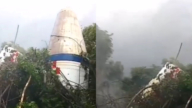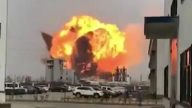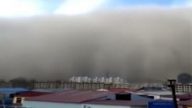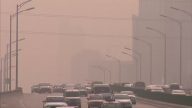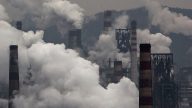【新唐人2012年7月6日讯】最近几天,四川 什邡以学生为主力军的“万民大冲突”,群众抗议兴建钼铜冶炼厂,遭千名特警血腥镇压。3号,什邡当局承诺,今后不再兴建这个项目,并释放了一部分被扣押的示威者。英国媒体报导认为,中国环保人士罕见获胜,但事件就此结束了吗? 示威者们表示,他们不能确信冶炼厂停止兴建的承诺是永久性的。另外,是谁下令武警对手无寸铁的学生进行血腥镇压? 对于死伤者,由谁承担刑事责任?这些问题应该由谁来回答并且负起责任?
地处中国西南部的四川什邡地区,是汶川大地震中的重灾区之一,最近当地一家钼铜冶炼厂破土动工,被民众知道后,居民担心冶炼厂将危害当地民众的健康,从7月1号开始举行了大规模的示威抗议活动。
当局派出近千名防暴察和武警血腥镇压,许多抗议民众被打得头破血流,上百人受伤,两名学生被打死。许多学生被抓捕。
3号晚,什邡政府宣布,鉴于部分群众担心钼铜项目建成后会影响环境,危及健康,反映强烈,当局决定今后不再建设这个项目﹔4号,什邡政府又发布公告声称,对推翻警车,向民警投掷花盆、砖头的6人予以拘留﹔其余21人认了错,被释放。
但4号当天仍有一批抗议民众在市委门前聚集,要求释放被当局扣押还没获释的学生。
5号,市委门外布防的警察一部分已撤走,但仍有警车不断的在市内巡逻。
对于这次什邡事件,罕见的是,中共当局没有像其他大规模群体事件那样控制舆论。网路上随处可见什邡大冲突现场的图片和视频。
对此,“权利运动”组织负责人胡军指出,这次什邡事件看似舆论放松了,但中共对待群体事件的镇压态度丝毫没变。
胡军:“这个事情继续这样打压,肯定会发生大的,走向真正武装暴动都可能发生,因为四川这个地方,因为汶川地震压得太久,还有四川这里面如果再压的话,四川的人口比较密集,他们相互的信息人传人非常快,很快四川就会动,整个都会动,这个形式所迫吧,逼迫他,有一点松。”
胡军指出,什邡政府这次肯让步,承诺停建钼铜项目,和大量的学生参与有直接关系。
胡军: “学生这块特别重要,因为他很快的沟通,每个人做什么分工各方面就非常密切,而且动员起来非常的快,他就会形成非常大的力量。孩子本身就和家长、社会直接有联系,这一块就非常有效的。”
胡军表示,这次事件不会就这样结束,谁调动的武警?武警调动权限在哪里?谁下令动用大批武警对手无寸铁的学生进行血腥镇压?这些人必须要承担刑事责任。
胡军: “我们要追这个问题,调动武警把这么多人打伤了,这些人都是谁打伤的,被打伤这些人我们应该对他们进行统计,统计出来然后报人,然后要求进行索赔,那么谁下令的,那谁就要承担法律责任。”
胡军指出,既然政府说这个项目停建,就证明兴建是错误的,那么,当时是谁下的这个决议?谁批的这个项目?现在即然知道错了,仍在扣押被抓捕的学生,这个都要追究责任。
虽然目前什邡政府宣布取消这个投资16亿美元的钼铜项目,但并不代表这个项目会消失。几年前厦门发生“PX项目事件”,当地居民担心发生泄漏或爆炸,在他们强烈的反对声中,项目暂停,但后来,这个项目悄声无息的迁到了福建漳州。
去年,大连市也有上万人示威抗议反对一家化工厂﹔大连市政府当时承诺关闭工厂,但至今化工厂仍在运行。
世界银行估计,每年至少有75万中国人因环境污染的原因早逝。
采访编辑/李韵 后制/萧宇
Temporary Win for Shifang Protestors
Recently ten-thousand people protested against construction
of a molybdenum copper plant in Shifang, Sichuan.
Students were the main force. The protest was met with a
bloody crackdown by one thousand special police.
On July 3, Shifang authorities promised not to resume
building, and released some detained demonstrators.
British media said Chinese environmentalists had
a rare win, but has the incident concluded?
Demonstrators say they are not convinced the decision
to terminate construction is a permanent commitment.
In addition, who ordered a bloody crackdown of unarmed
students with armed police?
Who will bear criminal liability and responsibility
to the victims?
Who will answer these questions and be held responsible?
Shifang, Sichuan Province is located in southwest China.
It is one of the areas hardest hit by the Wenchuan earthquake.
Recently, the construction of a local molybdenum copper
plant began.
After the people became aware, residents grew worried
that the plant endangered the health of local people.
From July 1, they held a large-scale protest.
The authorities sent nearly a thousand anti-riot police
and armed police to bloodily suppress.
Many protesters were severely beaten. Hundreds of people
were injured, two students were killed. Many students were arrested.
On the night of July 3, Shifang government announced that
they decided to stop the project due to the strong reaction
of residents worried the molybdenum copper project will
affect environment and endanger people’s health.
On July 4, Shifang government released an announcement
claiming six people who had overthrown police vehicles
and threw flower pots and bricks at police were detained;
the remaining 21 people recognized mistakes and were released.
On July 4, a number of protesters still gathered at the front
gate of the municipal committee, demanding the release of the detained students.
On July 5, part of the deployment of police had been
withdrawn, but there were still police cars patrolling the city.
It is rare that Chinese authorities did not control public
opinion of the Shifang event like in other large-scale incidents.
Pictures and videos of Shifang conflicts surfaced everywhere
online.
Hu Jun, the rights movement organization leader, pointed out
public opinions of Shifang events seem to be relaxed,
but the repressive attitude of the Chinese Communist Party
(CCP) towards the group events did not change at all.
Hu Jun: “If the authorities continue to suppress, they will
definitely occur on a large scale, or even real armed insurrection.
In Sichuan Province, the Wenchuan earthquake caused
great loss. If the Sichuan authorities continue to suppress,
all people in Sichuan will react because population of Sichuan
is relatively dense, and the news spread fast among people.
So the whole situation forced the government
to loosen control.”
Hu Jun said the reason the Shifang Government was willing
to compromise and commit to cease the
molybdenum copper project is directly related to
the participation of a large number of students.
Hu Jun: “Students are particularly important, because they
communicate fast and have very clear division in their work.
They can mobilize very fast, and form a very large force.
Students are also linked directly to parents and the society.
They (students) are very effective."
Hu Jun said that this incident will not end like this.
Who mobilized the armed police? Who has the power to do it?
Who ordered the armed police to conduct a bloody
crackdown of unarmed students?
These people must be criminally charged.
Hu Jun: “We have to follow up on this problem.
The armed police wounded so many people. Who injured them?
We should collect statistics of the wounded,
and then report for compensation?
Whoever made the order should bear legal responsibility."
Jun Hu pointed out that since the government had ceased
the project, evidence supports that its construction is wrong.
Who made the decision (to build it)? Who approved it?
Now they (CCP) know the project is wrong, but still detain
arrested students, they should be held accountable.
Although Shifang government announced the abolition
of the USD $1.6 billion molybdenum copper project,
it does not mean that this project will be taken off the table.
With regard to the Xiamen PX events a few years ago, local residents,
concerned about a leak or explosion, strongly opposed the project.
The project was suspended, but later, quietly relocated
to Zhangzhou, Fujian Province.
Last year, over ten thousand demonstrators protest against
a chemical plant in Dalian.
The Dalian municipal government also “committed”
to closing the plant, but it is still running now.
The World Bank estimates that every year, at least 750,000
Chinese people die at a young age due to environmental pollution.


